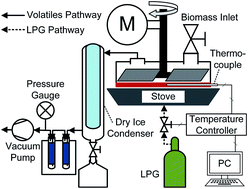Bio-oils from vacuum ablative pyrolysis of torrefied tobacco residues†
Abstract
Fast pyrolysis, in combination with torrefaction pretreatment, was used to convert tobacco residues to value-added bio-fuels and chemicals. Tobacco plant residues were torrefied at 220, 260, and 300 °C, before being pyrolyzed at 450, 500, 550, and 600 °C in a rotating blade ablative reactor under vacuum conditions to test the effects on product yields. With torrefaction, tobacco residues thermally decomposed 20–25% w/w at low temperatures. Torrefaction and pyrolysis temperatures were found to markedly affect pyrolytic product yields of bio-chars and bio-oils, while having no effect on gas-phase products. Bio-oil yields exhibited a direct relation with pyrolysis temperature and an inverse relation with torrefaction temperature. Bio-oils produced were separated into light and heavy oils and analyzed by GC-MS, and 1H and 13C NMR. Nicotine was found to be the main compound in the light and heavy oils along with several phenols and cresols in the heavy oil.



 Please wait while we load your content...
Please wait while we load your content...